(May 1954 – July 1954: Young Romance #69 – #71, Young Love #57 – #59, Young Brides #15 – #17)
Simon and Kirby had done more than well with romance, they had done great. Their deal with Prize entitled Joe and Jack to a share in the profits. While it is true that they had to pay all the expenses that were required to produce the art, the sales of the romance titles was high enough that Simon and Kirby made a lot of money. Much more than anything else they had produced. But this was going to change and the first signs of that change started now.
Young Brides was the third title of what for all practical purposes had the same format as the other two titles. Even so the title had been selling well enough that it went on a monthly release schedule with the October 1953 issue. However sales apparently did not remain high and Young Brides returned to a bimonthly schedule with the July issue.
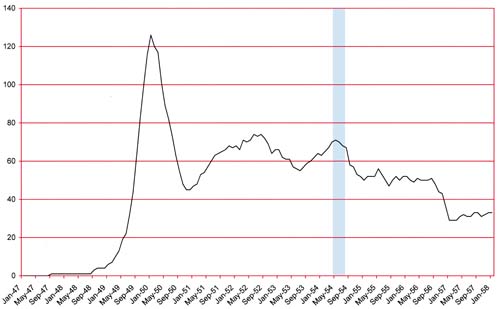
Number of Romance Titles 1947 – 1958 (the period covered in this chapter is shaded in blue)
Was schedule change for Young Brides just a sign that the Prize romance titles had reached the limit of what the market would bare? Perhaps, but it was also possible that Young Brides was just caught up in a bigger market change for comics in general. I have increased the period covered in the chart of the number of romance titles that I include in each chapter. I did this to provide a better perspective on what was occurring. June 1954 marked a local high in the number of romance titles published. There had been two previous peaks followed by recoveries but this time there would be no recovery. What was to come was actually a bit worse that the chart suggests. The chart shows a plateau of about 50 titles was reached by January 1955. However underlying that plateau was a steady decline in the number publishers doing romance comics. The chart also shows that a new plateau was reached at January 1957. But the number of romance titles at this time was inflated by Charlton’s desire to keep their presses running. For a more complete description of these events please see my post “The Real Reason for the Decline of Comics“. History had begun to catch up with Simon and Kirby.
I mentioned in my last chapter that I thought the story format may have been changing. Well I can verify that. Typically comic features started with a splash that served as a preview of the story. For the previous year Prize romance features started with a splash that was actually part of the story line, either that or no splash at all. Now the Prize romance titles return the splash to its traditional function. The format switch is not complete as some features continue to use the story splash or are splash-less.
However it is not a complete return to the earlier format. During the earlier years of Simon and Kirby romance productions at least some of the stories would have a full page splash but such large splashes remain absent as they did during the previous year. During the earlier years some features, and in particular the lead story, would have a splash where a protagonist would introduce the story and the word balloon would include the feature’s title. I call that format a confessional splash. The disappeared during the previous year and do not return.
In the comments to the last chapter, Bob Cosgrove pointed out that the logo for Young Love changed with issue #56 (April 1954). I totally missed that fact but Bob is correct. The new, more modern looking, logo would remain on Young Love for some time. The logos for Young Romance and Young Brides however would remain unchanged.
As I mentioned in the last chapter, this is a period where Jack Kirby does not appear in any of the Prize romance comics. I suspect that means I have lost 90% of my readers. But don’t loose heart fans, Jack will be back in the next chapter (just not in Prize romances). As I mentioned before, even though Kirby art does not appear in these romance comics that does not mean they are now longer Simon and Kirby productions. The lead story is clearly marked as such and the same artists appear. Also Joe Simon’s collection still contains some cover proofs. One of them is the cover for Young Brides #16 (June), only it is not the one eventually published there but instead was published as Young Love #57 (May). Another proof shows that the cover that was actually published as Young Brides #16 (June) was first considered for Young Brides #15 (May).
In prior chapter Kirby’s absence was taken up by John Prentice and Bob McCarty. While those artists remain important contributors to the romance titles the number one spot is taken by Mort Meskin. This is a surprising turn as Mort had been a minor player for a little over a year. However cover art was still dominated by Prentice (4 covers) and McCarty (3 covers) with Meskin and Draut only contributing a cover each. The line up for this chapter is Meskin (57 pages), McCarty (38 pages), Prentice (34 pages), unidentified artist A (34 pages), unidentified artist B (24 pages), Draut (19 pages), unidentified artist C (12 pages) and Gates (8 pages). Note the significant presence of three unidentified artist. After a period where most of the work was done by the same set of artists (Kirby, Draut, Meskin, Prentice, McCarty and Eadeh), the studio now enters a time where new faces appear. However the artists working on the Prize romance titles are still different from those used in Prize Comics Western, Headline and Justice Traps the Guilty (titles not produced by Simon and Kirby at this time).
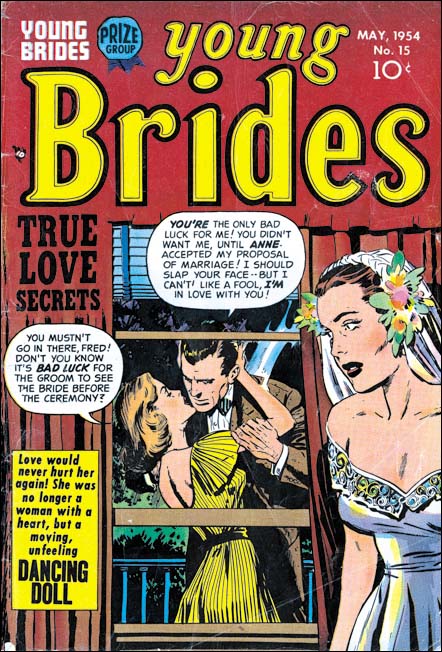
Young Brides #15 (May 1954), art by Bob McCarty
One of the big dividends of my reviewing the all the romance titles in sequence is I now realize that some of the work that I previously attributed to John Prentice was actually done by Bob McCarty. At this point in time they have similar art styles both being heavily influenced by Alex Raymond. They generally can most easily be distinguished by their different manners of drawing eyes on men; McCarty are larger and more open and Prentice smaller and almost beady eyed. This attribution technique works well with stories but is more problematical with covers. The cover for Young Brides #15 is an example where this attribution technique is just not helpful.
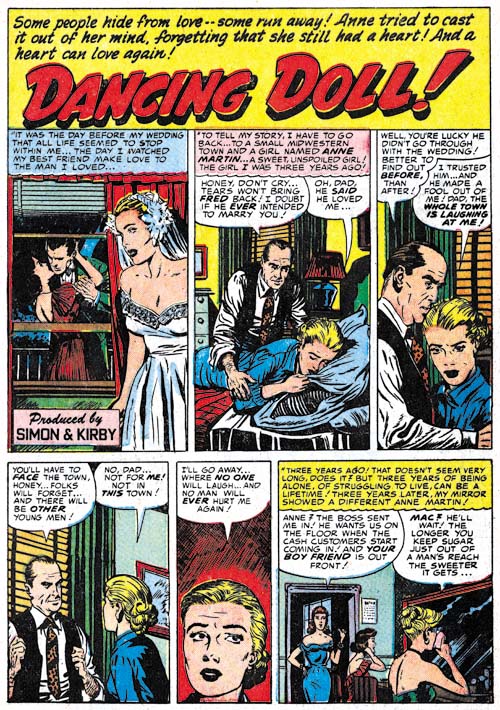
Young Brides #15 (May 1954) “Dancing Doll”, art by Bob McCarty
Fortunately for the cover for Young Brides #15 is based on first story panel for “Dancing Doll” which includes pages that obviously were done by Bob McCarty. The cover and story panel are not just similar they are so close that without doubt one is based on a stat taken from the other. I believe it is the cover that was based on a stat of the splash because that was the technique used by another example that will be discussed in a future chapter. However it is not simply of using a stat because both the cover and the splash include art that does not appear on the other. This is the earliest use of stats in a Simon and Kirby production that I have found. There will be more and all cases involve the cover.
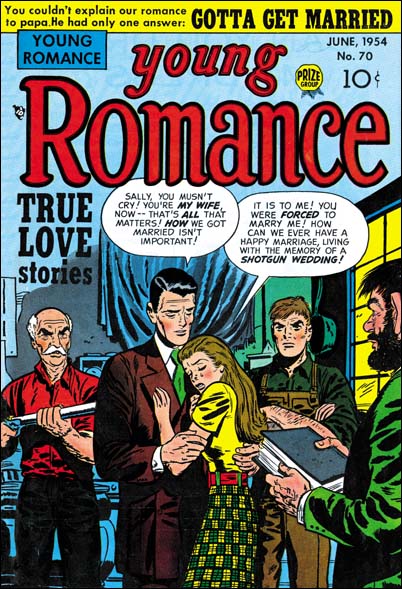
Young Romance #70 (June 1954), art by Bill Draut
I mentioned above that Bill Draut did a single cover during this period (Young Romance #70). But there is a catch in that this is another case of a cover being based on a stat of the splash of the story “Gotta Get Married”.
Bill Draut is a relatively minor player in the romance titles during this period. This may be due to the same reason as Jack Kirby’s absence as Draut played an important hand in one of the Mainline titles that will soon appear.
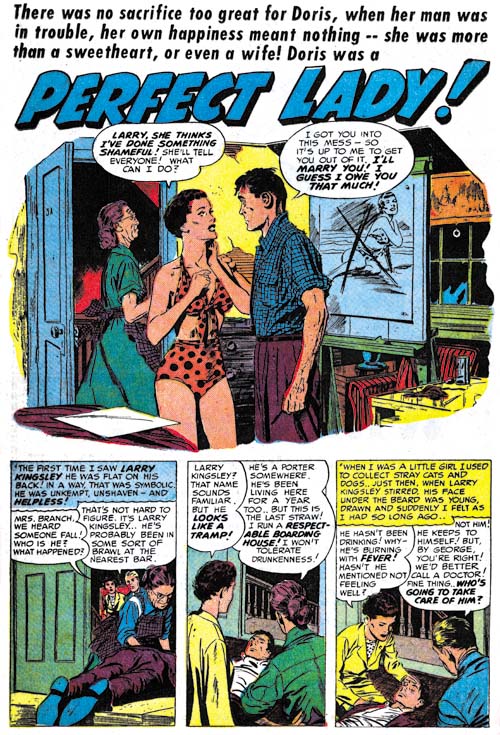
Young Love #58 (June 1954) “Perfect Lady”, art by John Prentice
I cannot resist the artist and model theme, and apparently neither could Simon and Kirby. John would do the cover for Young Love #58 based on the “Perfect Lady” as well. For interior he uses the borderless splash that I find so effective.
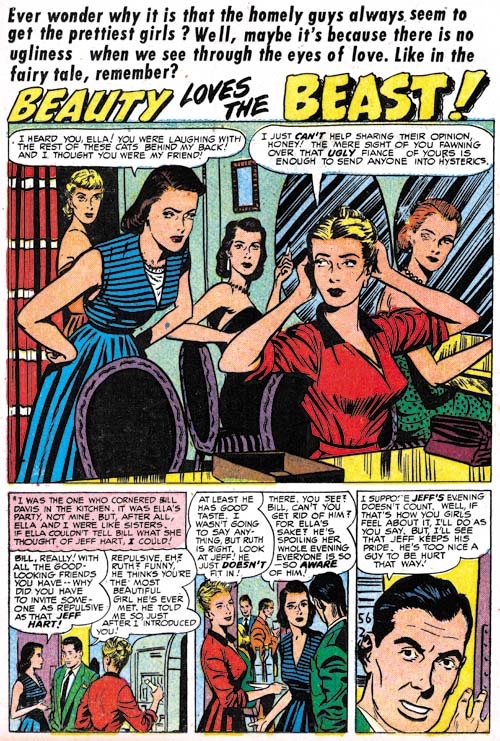
Young Romance #71 (July 1954) “Beauty Loves the Beast”, art by Bob McCarty
The “Beauty Loves the Beast” provides a good example of McCarty’s art during this period. Note the larger eyes of the man in the last panel. But also observe how similar the women are to those drawn by John Prentice. They are not identical but are close enough to make distinguishing the two artists difficult.

Young Brides #15 (May 1954) “Lavender and Old Lies”, art by Bob McCarty
The first page of “Lavender and Old Lies” is not as good example of McCarty’s art as “Beauty Loves the Beast”. However I could not resist a splash with so much skin. Woman in swimsuits do appear in these romance comics from time to time but it is unusual for a man to be so prominently displayed.
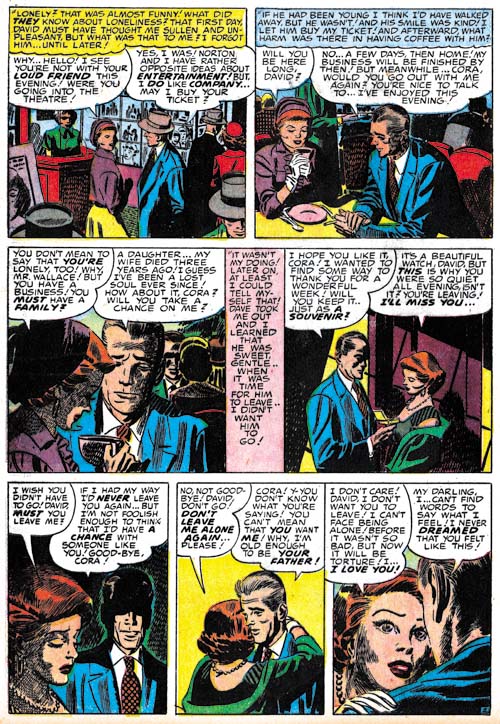
Young Romance #71 (July 1954) “Forsaking All Others” page 2, art by Mort Meskin
Not surprisingly Mort Meskin does some nice work but I wanted to show the inking found in some of this work. Note the fine crosshatching on the faces in panel 3, 5 and 7. While Meskin’s inking technique includes crosshatching it usually is not so fine. I suspect that some of these stories were inked by another artist.
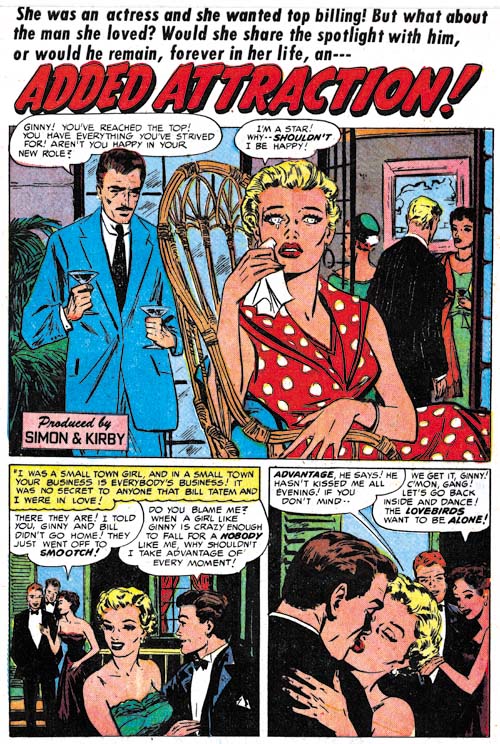
Young Romance #69 (May 1954) “Added Attraction”, art by unidentified artist
As I mentioned above there are some unidentified artists found during this period. Such unknown artists had appeared during previous periods but usually not so prominently. One of the unidentified artists not only tied John Prentice for third place but also did the lead story for Young Romance #69, “Added Attraction”. Whoever this artist is he has a more modern style than most of the other studio artists.
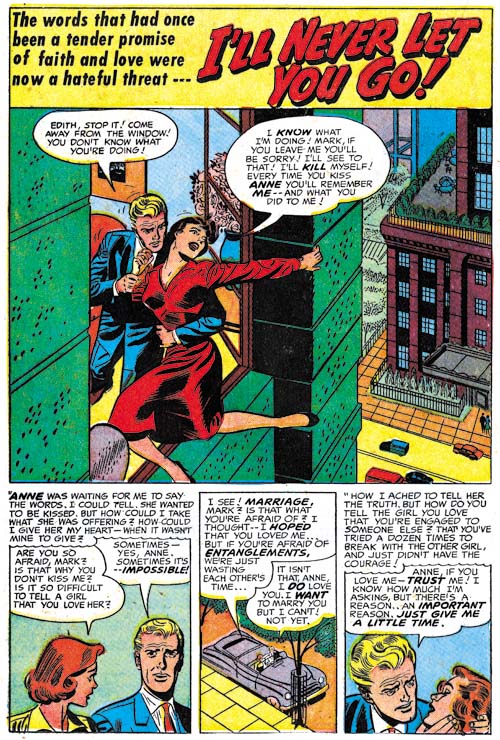
Young Romance #69 (May 1954) “I’ll Never Let You Go”, art by unidentified artist
The second unknown artist is not as talented as the one discussed above but he does have his dramatic moments. He has a manner of providing his men with unusual eyebrows. The eyebrows give his men a somewhat puzzled look.
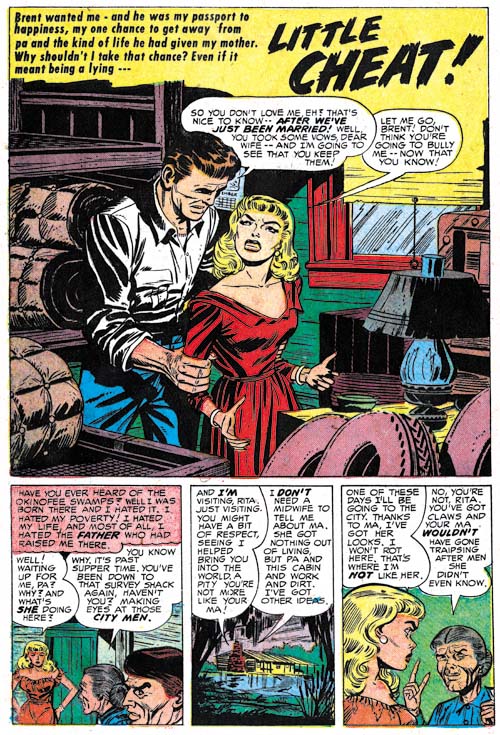
Young Love #59 (June 1954) “Little Cheat”, art by unidentified artist
The third unknown artist is no where near as talented as the other two. I might have skipped him in this post altogether except look at the splash from “Little Cheat”. The splash, and in particular the woman, look like something Kirby might do. In cases like this it is hard to be sure what is going on. Only the splash looks so Kirby-like. I believe this is a case of someone swiping Kirby and not someone working from a Kirby layout of the splash. But it is hard to be certain.
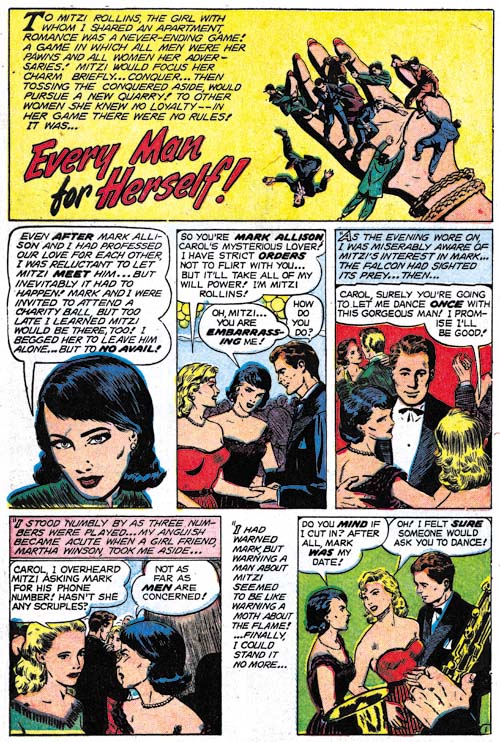
Young Brides #17 (July 1954) “Every Man for Herself”, art by Art Gates
Art Gates generally provides single page features but “Every Man for Herself” but is longer but at three pages not by much. Gates was an unusual artist in that he did both cartoon-like gag features and more realistic work.
Chapter 1, A New Genre (YR #1 – #4)
Chapter 2, Early Artists (YR #1 – #4)
Chapter 3, The Field No Longer Their’s Alone (YR #5 – #8)
Chapter 4, An Explosion of Romance (YR #9 – #12, YL #1 – #4)
Chapter 5, New Talent (YR #9 – 12, YL #1 – #4)
Chapter 6, Love on the Range (RWR #1 – #7, WL #1 – #6)
Chapter 7, More Love on the Range (RWR #1 – #7, WL #1 – #6)
Chapter 8, Kirby on the Range? (RWR #1 – #7, WL #1 – #6)
Chapter 9, More Romance (YR #13 – #16, YL #5 – #6)
Chapter 10, The Peak of the Love Glut (YR #17 – #20, YL #7 – #8)
Chapter 11, After the Glut (YR #21 – #23, YL #9 – #10)
Chapter 12, A Smaller Studio (YR #24 – #26, YL #12 – #14)
Chapter 13, Romance Bottoms Out (YR #27 – #29, YL #15 – #17)
Chapter 14, The Third Suspect (YR #30 – #32, YL #18 – #20)
Chapter 15, The Action of Romance (YR #33 – #35, YL #21 – #23)
Chapter 16, Someone Old and Someone New (YR #36 – #38, YL #24 – #26)
Chapter 17, The Assistant (YR #39 – #41, YL #27 – #29)
Chapter 18, Meskin Takes Over (YR #42 – #44, YL #30 – #32)
Chapter 19, More Artists (YR #45 – #47, YL #33 – #35)
Chapter 20, Romance Still Matters (YR #48 – #50, YL #36 – #38, YB #1)
Chapter 21, Roussos Messes Up (YR #51 – #53, YL #39 – #41, YB #2 – 3)
Chapter 22, He’s the Man (YR #54 – #56, YL #42 – #44, YB #4)
Chapter 23, New Ways of Doing Things (YR #57 – #59, YL #45 – #47, YB #5 – #6)
Chapter 24, A New Artist (YR #60 – #62, YL #48 – #50, YB #7 – #8)
Chapter 25, More New Faces (YR #63 – #65, YLe #51 – #53, YB #9 – #11)
Chapter 26, Goodbye Jack (YR #66 – #68, YL #54 – #56, YB #12 – #14)
Chapter 27, The Return of Mort (YR #69 – #71, YL #57 – #59, YB #15 – #17)
Chapter 28, A Glut of Artists (YR #72 – #74, YL #60 – #62, YB #18 & #19, IL #1 & #2)
Chapter 29, Trouble Begins (YR #75 – #77, YL #63 – #65, YB #20 – #22, IL #3 – #5)
Chapter 30, Transition (YR #78 – #80, YL #66 – #68, YBs #23 – #25, IL #6, ILY #7)
Chapter 30, Appendix (YB #23)
Chapter 31, Kirby, Kirby and More Kirby (YR #81 – #82, YL #69 – #70, YB #26 – #27)
Chapter 32, The Kirby Beat Goes On (YR #83 – #84, YL #71 – #72, YB #28 – #29)
Chapter 33, End of an Era (YR #85 – #87, YL #73, YB #30, AFL #1)
Chapter 34, A New Prize Title (YR #88 – #91, AFL #2 – #5, PL #1 – #2)
Chapter 35, Settling In ( YR #92 – #94, AFL #6 – #8, PL #3 – #5)
Appendix, J.O. Is Joe Orlando
Chapter 36, More Kirby (YR #95 – #97, AFL #9 – #11, PL #6 – #8)
Chapter 37, Some Surprises (YR #98 – #100, AFL #12 – #14, PL #9 – #11)
Chapter 38, All Things Must End (YR #101 – #103, AFL #15 – #17, PL #12 – #14)


Happy New Year! Working from the scans you provide, I’d say that the first unidentified artist has Vince Coletta’s look al over it. That doesn’t say much, as he worked with different pencililers in his own ‘studio’. The second unknown has a dc-ish look to it. I don’t have those issues but in my notes I have a possible Stallman appearing around that time. Those notes are three years old, though. The third unknown looks like Infantino to me. But I agree with you that the woman looks swiped and I don’t think Infantino used a lot of swipes.
By the way, my notes also have Albister appearing in Young Love #61 and possibly #60, so I am curious what you’ll make of it next time.
Interesting comment about Coletta. Frankly I am not that familiar with his style, either as a penciler or an inker. Was he active this early?
The romance story does not look like Infantino’s earlier stuff but I have not followed Infantino’s style after he last worked for Simon and Kirby (Charlie Chan).
“I’ll Never Let You Go” looks very much like Jim Mooney was involved in the artwork. Did he ever do any work for Prize or S&K?
Nick Caputo
Nick,
Certainly Jim Mooney never signed a Simon and Kirby piece but not all artists did. I am not familiar with Mooney’s style but thanks for the suggestion I’ll have to check it out sometime.